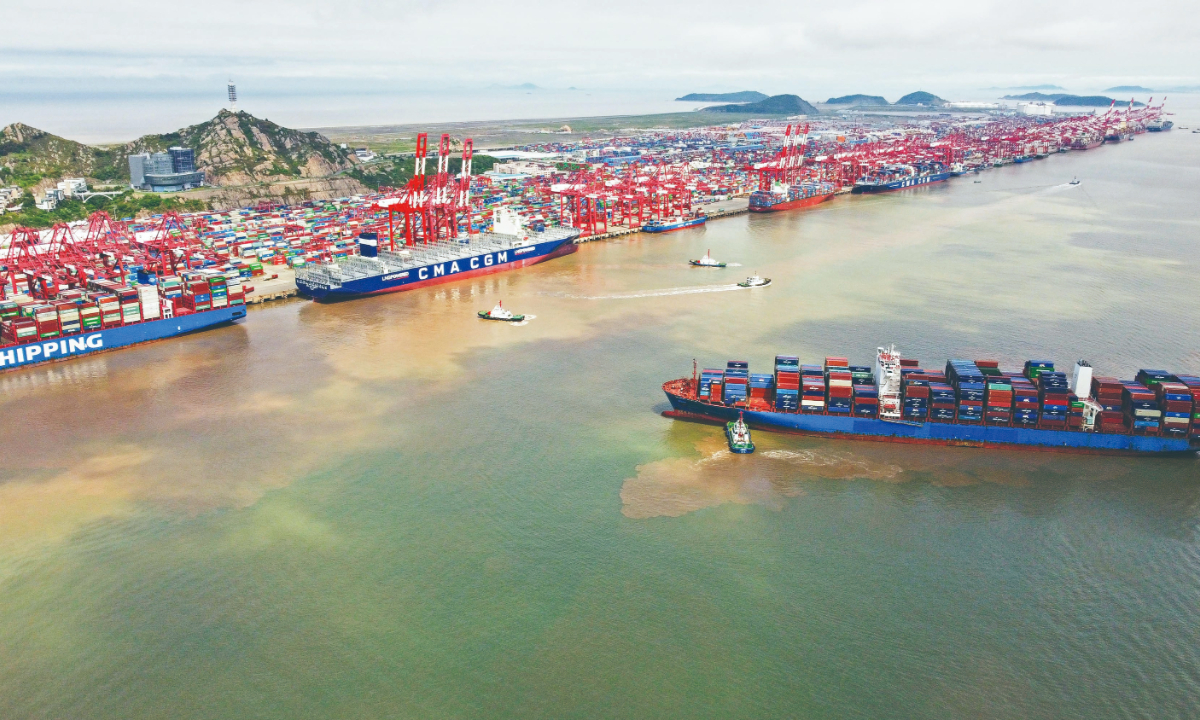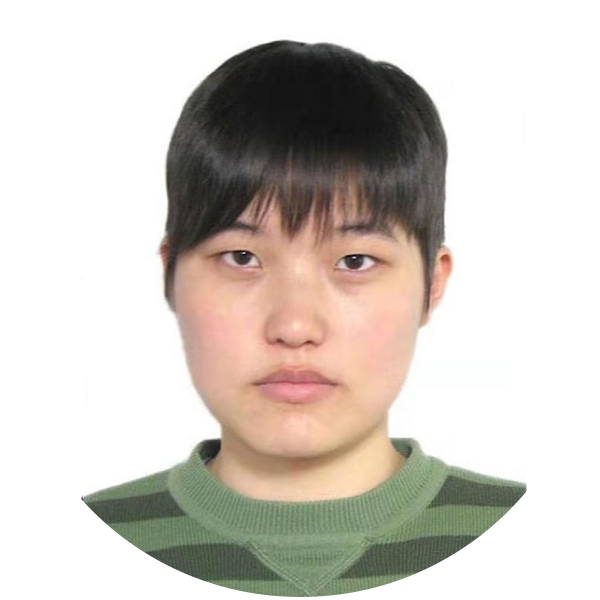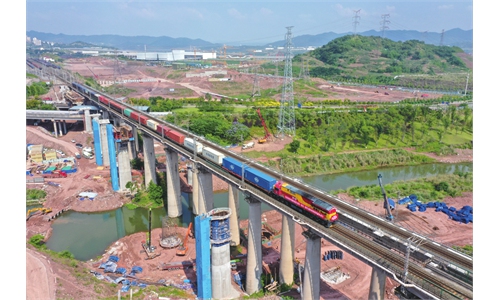
Aerial photo of Shanghai's Yangshan Port on April 24, 2022 Photo: cnsphoto
China on Wednesday doubled down on efforts to stabilize its economy, with a slew of new measures introduced for the trade sector as part of an imperative push to ensure the economy's reasonable growth over the second quarter.
The fresh official avowal is envisioned to support the trade sector out of a low ebb, experts said, estimating that China's trade could grow by more than 5 percent over the whole of 2022, thereby effectively underpinning the larger economic revival.
An executive meeting of the State Council, the country's cabinet, on Wednesday called for ramped-up support for the country's foreign trade and investment.
The meeting presided over by Premier Li Keqiang vowed tax rebates in stages within three working days for businesses with sound creditworthiness in export tax rebates, an expansion of imports of high-quality goods and an acceleration in port loading, unloading, transshipment and customs clearance.
Free trade deals such as the Regional Comprehensive Economic Partnership would be banked on to facilitate trade, per the meeting readout published by Xinhua News Agency.
Greater policy support
The meeting also eyed maintaining global supply chain stability and a phased reduction and exemption of port-related charges, as well as urging the creation of a market-oriented and law-abiding international business environment to lure foreign businesses into the domestic investment.
The cabinet meeting stressed that downward pressure on the economy remains prominent and that it is imperative to effectively coordinate coronavirus containment efforts with economic and social development.
Local governments across the country are requested to earnestly shoulder the responsibility of ensuring the well-being of local people's livelihoods and push for the implementation of economic stability policies with a sense of urgency so there will be reasonable economic growth in the second quarter.
Earlier on Wednesday, officials announced the rollout of about a dozen measures to solve the bottlenecks currently faced by the domestic trade sector, ranging from sustaining loans for small enterprises and maintaining smooth logistics as the nation's production and logistics gradually return to normal.
At a press conference on Wednesday morning, China's Vice Commerce Minister Wang Shouwen elaborated on the newest package of policies China is ready to take to help relieve the difficulties faced by domestic trade companies. A key part of the 13 measures is ensuring the smooth running of logistics.
According to Wang, China will set a catalogue for key trade companies and logistics companies to safeguard their production, logistics and employment. It is also including trade commodities into the scope of crucial resources to smooth out logistics at sea ports and airports.
In terms of financial support, the Chinese government will expand the short-term insurance scale of export credit insurance, especially for small and micro businesses. It will also support banking institutions not to cut or suppress loans for trade companies, while increasing the strength of promotion and training for companies on exchange rate risk aversion and cross-border renminbi payment settlement, according to the press conference.
Wang said that China will improve and innovate online exhibitions to help companies obtain more orders, as well as encourage overseas consumers to purchase Chinese brand automobiles.
"The Ministry of Commerce will direct local governments to roll out localized support measures that target trade difficulties, so companies can achieve stable growth by enjoying policy bonuses amid the uncertainties," Wang said.
China is rolling out policies to support trade companies at a time when the sector is facing both unexpected short-term blows, arising from Omicron outbreaks in metropolises like Shenzhen and Shanghai, and challenges on a longer basis, including the influence of Western sanctions against Russia and the Ukraine crisis, which will exert a negative influence on China's industrial chain stability and in turn affect China's trade supply side, experts said.
The global grain and energy crisis will also influence China's bulk commodity transaction price and further affect global demands for Chinese products, they said.
"The consequences of those challenges will add up in China's trade supply and demand sides and emerge gradually, with China's trade scale and growth likely to edge down sharply in the second quarter after going through a temporary peak in Q1," Chen Jia, a research fellow at the International Monetary Institute of the Renmin University of China, told the Global Times on Wednesday.
China's exports growth fell to 3.9 percent in April, compared with 14.7 percent in the previous month, the weakest level since June 2020, customs data showed.
The pro-trade measures epitomize the country's broad-based push for an economic revival that centers on the genuinely efficient implementation of varied policy measures.
The cabinet meeting on Wednesday reiterated a call for policy implementation by governments at varying levels.
At a keenly watched video conference with upwards of 100,000 participants on May 25, the premier urged policies crystallized by the Central Economic Work Conference in December and the annual government work report this March to be basically implemented in the first half. In addition, a slew of stabilization policies unveiled at an earlier State Council executive meeting ought to be complemented by rules for implementation by the end of May.
The General Office of the State Council would also circulate typical issues found in a special inspection around 12 provinces and regions of policy implementation aimed at stabilizing growth and ensuring market entities and employment. Furthermore, the general office would oversee the overhaul efforts in the wake of the inspection.
Trade rebound
On the other hand, the measures are being launched at a time when China's economy is stepping out of the darkest period amid the recent coronavirus outbreaks, and sectors like logistics are starting to return to normal, which will support a turnaround in the trade sector as well, experts said.
"Now that companies have resumed production for a certain period of time, and logistics are normal, the trade sector is ready to rebound under policy support," Hu Qimu, chief research fellow at the Sinosteel Economic Research Institute, told the Global Times on Wednesday.
Experts are generally positive about China's trade situation and the general economy in the second half of this year, despite some gloomy projections on China's economic prospects this year by overseas institutions.
The World Bank recently lowered its prediction of China's 2022 GDP growth to 4.3 percent, from the 8.1 percent growth of 2021.
According to Hu, the recent disruptions in the second quarter are unlikely to shake China's trade situation in the whole year, as China's position in global industrial chains cannot be replaced easily due to its advantages in the business environment, labor force maturity and other areas.
"China's competitiveness has not changed. It is still the world's manufacturing basis," Hu said, adding that China's low inflation will make its products the best choice for many countries, and there may possibly be a wave of orders reflow back into China in the upcoming months as overseas countries search for solutions to relieve inflation pressure.
Tian Yun, a veteran macroeconomic analyst, also told the Global Times on Wednesday that China's incremental trade volume in 2022 should still be the largest among global economies, if its trade growth rate might not get to the top.
According to him, as long as other countries' product price continues a surging trend, there's space for China's exports to grow. Besides, the rebound of China's internal market demands will also benefit some trade companies. He predicted that China's exports and imports might grow by around 6 percent in 2022.




